16-cell
| Regular hexadecachoron (16-cell) (4-orthoplex) | |
|---|---|
|
Schlegel diagram (vertices and edges) | |
| Type |
Convex regular 4-polytope 4-orthoplex 4-demicube |
| Schläfli symbol | {3,3,4} |
| Coxeter diagram |
|
| Cells |
16 {3,3} |
| Faces |
32 {3} |
| Edges | 24 |
| Vertices | 8 |
| Vertex figure |
 Octahedron |
| Petrie polygon | octagon |
| Coxeter group |
B4, [3,3,4], order 384 D4, order 192 |
| Dual | Tesseract |
| Properties | convex, isogonal, isotoxal, isohedral, quasiregular |
| Uniform index | 12 |
In four-dimensional geometry, a 16-cell is a regular convex 4-polytope. It is one of the six regular convex 4-polytopes first described by the Swiss mathematician Ludwig Schläfli in the mid-19th century. It is also called C16, hexadecachoron, or hexdecahedroid.[1]
It is a part of an infinite family of polytopes, called cross-polytopes or orthoplexes. The dual polytope is the tesseract (4-cube). Conway's name for a cross-polytope is orthoplex, for orthant complex. The 16-cell has 16 cells as the tesseract has 16 vertices.
Geometry
It is bounded by 16 cells, all of which are regular tetrahedra. It has 32 triangular faces, 24 edges, and 8 vertices. The 24 edges bound 6 squares lying in the 6 coordinate planes.
The eight vertices of the 16-cell are (±1, 0, 0, 0), (0, ±1, 0, 0), (0, 0, ±1, 0), (0, 0, 0, ±1). All vertices are connected by edges except opposite pairs.
The Schläfli symbol of the 16-cell is {3,3,4}. Its vertex figure is a regular octahedron. There are 8 tetrahedra, 12 triangles, and 6 edges meeting at every vertex. Its edge figure is a square. There are 4 tetrahedra and 4 triangles meeting at every edge.
The 16-cell can be decomposed into two similar disjoint circular chains of eight tetrahedrons each, four edges long. Each chain, when stretched out straight, forms a Boerdijk–Coxeter helix. This decomposition can be seen in a 4-4 duoantiprism construction of the 16-cell: ![]()
![]()
![]()
![]()
![]()
![]()
![]() or
or ![]()
![]()
![]()
![]()
![]()
![]()
![]() , Schläfli symbol {2}⨂{2} or s{2}s{2}, symmetry [[4,2+,4]], order 64.
, Schläfli symbol {2}⨂{2} or s{2}s{2}, symmetry [[4,2+,4]], order 64.
The 16-cell can be dissected into two octahedral pyramids, which share a new octahedron base through the 16-cell center.
Images
 Stereographic projection |  A 3D projection of a 16-cell performing a simple rotation. |
 The 16-cell has two Wythoff constructions, a regular form and alternated form, shown here as nets, the second being represented by alternately two colors of tetrahedral cells. |
Orthogonal projections
| Coxeter plane | B4 | B3 / D4 / A2 | B2 / D3 |
|---|---|---|---|
| Graph |  |
 |
 |
| Dihedral symmetry | [8] | [6] | [4] |
| Coxeter plane | F4 | A3 | |
| Graph |  |
 | |
| Dihedral symmetry | [12/3] | [4] |
Tessellations
One can tessellate 4-dimensional Euclidean space by regular 16-cells. This is called the 16-cell honeycomb and has Schläfli symbol {3,3,4,3}. Hence, the 16-cell has a dihedral angle of 120°.[2] The dual tessellation, 24-cell honeycomb, {3,4,3,3}, is made of by regular 24-cells. Together with the tesseractic honeycomb {4,3,3,4}, these are the only three regular tessellations of R4. Each 16-cell has 16 neighbors with which it shares a tetrahedron, 24 neighbors with which it shares only an edge, and 72 neighbors with which it shares only a single point. Twenty-four 16-cells meet at any given vertex in this tessellation.
Boerdijk–Coxeter helix
A 16-cell can constructed from two Boerdijk–Coxeter helixes of eight chained tetrahedra, each folded into a 4-dimensional ring. The 16 triangle faces can be seen in a 2D net within a triangular tiling, with 6 triangles around every vertex. The purple edges represent the Petrie polygon of the 16-cell.
Projections
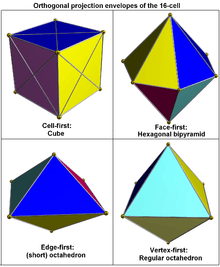
The cell-first parallel projection of the 16-cell into 3-space has a cubical envelope. The closest and farthest cells are projected to inscribed tetrahedra within the cube, corresponding with the two possible ways to inscribe a regular tetrahedron in a cube. Surrounding each of these tetrahedra are 4 other (non-regular) tetrahedral volumes that are the images of the 4 surrounding tetrahedral cells, filling up the space between the inscribed tetrahedron and the cube. The remaining 6 cells are projected onto the square faces of the cube. In this projection of the 16-cell, all its edges lie on the faces of the cubical envelope.
The cell-first perspective projection of the 16-cell into 3-space has a triakis tetrahedral envelope. The layout of the cells within this envelope are analogous to that of the cell-first parallel projection.
The vertex-first parallel projection of the 16-cell into 3-space has an octahedral envelope. This octahedron can be divided into 8 tetrahedral volumes, by cutting along the coordinate planes. Each of these volumes is the image of a pair of cells in the 16-cell. The closest vertex of the 16-cell to the viewer projects onto the center of the octahedron.
Finally the edge-first parallel projection has a shortened octahedral envelope, and the face-first parallel projection has a hexagonal bipyramidal envelope.
4 sphere Venn Diagram
The usual projection of the 16-cell  and 4 intersecting spheres (a Venn diagram of 4 sets) form topologically the same object in 3D-space:
and 4 intersecting spheres (a Venn diagram of 4 sets) form topologically the same object in 3D-space:
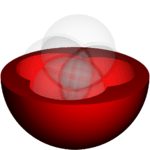 |
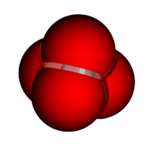
|

|
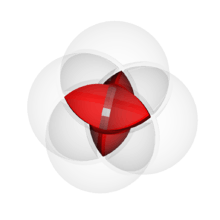
|
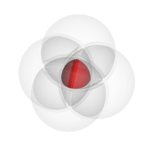 |
Symmetry constructions
There is a lower symmetry form of the 16-cell, called a demitesseract or 4-demicube, a member of the demihypercube family, and represented by h{4,3,3}, and Coxeter diagrams ![]()
![]()
![]()
![]()
![]()
![]()
![]() or
or ![]()
![]()
![]()
![]()
![]() . It can be drawn bicolored with alternating tetrahedral cells.
. It can be drawn bicolored with alternating tetrahedral cells.
It can also be seen in lower symmetry form as a tetrahedral antiprism, constructed by 2 parallel tetrahedra in dual configurations, connected by 8 (possibly elongated) tetrahedra. It is represented by s{2,4,3}, and Coxeter diagram: ![]()
![]()
![]()
![]()
![]()
![]()
![]() .
.
It can also be seen as a snub 4-orthotope, represented by s{21,1,1}, and Coxeter diagram: ![]()
![]()
![]()
![]()
![]()
![]()
![]() or
or ![]()
![]()
![]()
![]()
![]() .
.
With the tesseract constructed as a 4-4 duoprism, the 16-cell can be seen as its dual, a 4-4 duopyramid.
| Name | Coxeter diagram | Schläfli symbol | Coxeter notation | Order | Vertex figure |
|---|---|---|---|---|---|
| Regular 16-cell | {3,3,4} | [3,3,4] | 384 | ||
| Demitesseract | h{4,3,3} {3,31,1} |
[31,1,1] = [1+,4,3,3] | 192 | ||
| Alternated 4-4 duoprism | 2s{4,2,4} | [[4,2<sup>+</sup>,4]] | 64 | ||
| Tetrahedral antiprism | s{2,4,3} | [2+,4,3] | 48 | ||
| Alternated square prism prism | sr{2,2,4} | [(2,2)+,4] | 16 | ||
| Snub 4-orthotope | s{21,1,1} | [2,2,2]+ = [21,1,1]+ | 8 | ||
| 4-fusil | |||||
| {3,3,4} | [3,3,4] | 384 | |||
| {4}+{4} or 2{4} | [[4,2,4]] = [8,2+,8] | 128 | |||
| {3,4}+{ } | [4,3,2] | 96 | |||
| {4}+2{ } | [4,2,2] | 32 | |||
| { }+{ }+{ }+{ } or 4{ } | [2,2,2] | 16 |
Related complex polygons
The Möbius–Kantor polygon is a regular complex polygon 3{3}3, ![]()
![]()
![]() , in shares the same vertices as the 16-cell. It has 8 vertices, and 8 3-edges.[3] [4]
, in shares the same vertices as the 16-cell. It has 8 vertices, and 8 3-edges.[3] [4]
The regular complex polygon, 2{4}4, ![]()
![]()
![]() , in has a real representation as a 16-cell in 4-dimensional space with 8 vertices, 16 2-edges, only half of the edges of the 16-cell. Its symmetry is 4[4]2, order 32. [5]
, in has a real representation as a 16-cell in 4-dimensional space with 8 vertices, 16 2-edges, only half of the edges of the 16-cell. Its symmetry is 4[4]2, order 32. [5]
 In B4 Coxeter plane, 2{4}4 has 8 vertices and 16 2-edges, shown here with 4 sets of colors. |
 The 8 vertices are grouped in 2 sets (shown red and blue), each only connected with edges to vertices in the other set, making this polygon a complete bipartite graph, K4,4.[6] |
Related uniform polytopes and honeycombs
The regular 16-cell along with the tesseract exist in a set of 15 uniform 4-polytopes with the same symmetry. It is also a part of the uniform polytopes of D4 symmery.
This 4-polytope is also related to the cubic honeycomb, order-4 dodecahedral honeycomb, and order-4 hexagonal tiling honeycomb which all have octahedral vertex figures.
It is in a sequence to three regular 4-polytopes: the 5-cell {3,3,3}, 600-cell {3,3,5} of Euclidean 4-space, and the order-6 tetrahedral honeycomb {3,3,6} of hyperbolic space. All of these have a tetrahedral cells.
It is first in a sequence of quasiregular polytopes and honeycombs h{4,p,q}, and a half symmetry sequence, for regular forms {p,3,4}.
See also
Fundamental convex regular and uniform polytopes in dimensions 2–10 | ||||||||||||
|---|---|---|---|---|---|---|---|---|---|---|---|---|
| Family | An | Bn | I2(p) / Dn | E6 / E7 / E8 / E9 / E10 / F4 / G2 | Hn | |||||||
| Regular polygon | Triangle | Square | p-gon | Hexagon | Pentagon | |||||||
| Uniform polyhedron | Tetrahedron | Octahedron • Cube | Demicube | Dodecahedron • Icosahedron | ||||||||
| Uniform 4-polytope | 5-cell | 16-cell • Tesseract | Demitesseract | 24-cell | 120-cell • 600-cell | |||||||
| Uniform 5-polytope | 5-simplex | 5-orthoplex • 5-cube | 5-demicube | |||||||||
| Uniform 6-polytope | 6-simplex | 6-orthoplex • 6-cube | 6-demicube | 122 • 221 | ||||||||
| Uniform 7-polytope | 7-simplex | 7-orthoplex • 7-cube | 7-demicube | 132 • 231 • 321 | ||||||||
| Uniform 8-polytope | 8-simplex | 8-orthoplex • 8-cube | 8-demicube | 142 • 241 • 421 | ||||||||
| Uniform 9-polytope | 9-simplex | 9-orthoplex • 9-cube | 9-demicube | |||||||||
| Uniform 10-polytope | 10-simplex | 10-orthoplex • 10-cube | 10-demicube | |||||||||
| Uniform n-polytope | n-simplex | n-orthoplex • n-cube | n-demicube | 1k2 • 2k1 • k21 | n-pentagonal polytope | |||||||
| Topics: Polytope families • Regular polytope • List of regular polytopes and compounds | ||||||||||||
References
- T. Gosset: On the Regular and Semi-Regular Figures in Space of n Dimensions, Messenger of Mathematics, Macmillan, 1900
- H.S.M. Coxeter:
- Coxeter, Regular Polytopes, (3rd edition, 1973), Dover edition, ISBN 0-486-61480-8, p. 296, Table I (iii): Regular Polytopes, three regular polytopes in n-dimensions (n≥5)
- H.S.M. Coxeter, Regular Polytopes, 3rd Edition, Dover New York, 1973, p. 296, Table I (iii): Regular Polytopes, three regular polytopes in n-dimensions (n≥5)
- Kaleidoscopes: Selected Writings of H.S.M. Coxeter, edited by F. Arthur Sherk, Peter McMullen, Anthony C. Thompson, Asia Ivic Weiss, Wiley-Interscience Publication, 1995, ISBN 978-0-471-01003-6
- (Paper 22) H.S.M. Coxeter, Regular and Semi Regular Polytopes I, [Math. Zeit. 46 (1940) 380-407, MR 2,10]
- (Paper 23) H.S.M. Coxeter, Regular and Semi-Regular Polytopes II, [Math. Zeit. 188 (1985) 559-591]
- (Paper 24) H.S.M. Coxeter, Regular and Semi-Regular Polytopes III, [Math. Zeit. 200 (1988) 3-45]
- John H. Conway, Heidi Burgiel, Chaim Goodman-Strass, The Symmetries of Things 2008, ISBN 978-1-56881-220-5 (Chapter 26. pp. 409: Hemicubes: 1n1)
- Norman Johnson Uniform Polytopes, Manuscript (1991)
- N.W. Johnson: The Theory of Uniform Polytopes and Honeycombs, Ph.D. (1966)
External links
- Olshevsky, George. "Hexadecachoron". Glossary for Hyperspace. Archived from the original on 4 February 2007.
- Der 16-Zeller (16-cell) Marco Möller's Regular polytopes in R4 (German)
- Description and diagrams of 16-cell projections
- Klitzing, Richard. "4D uniform polytopes (polychora) x3o3o4o - hex".


